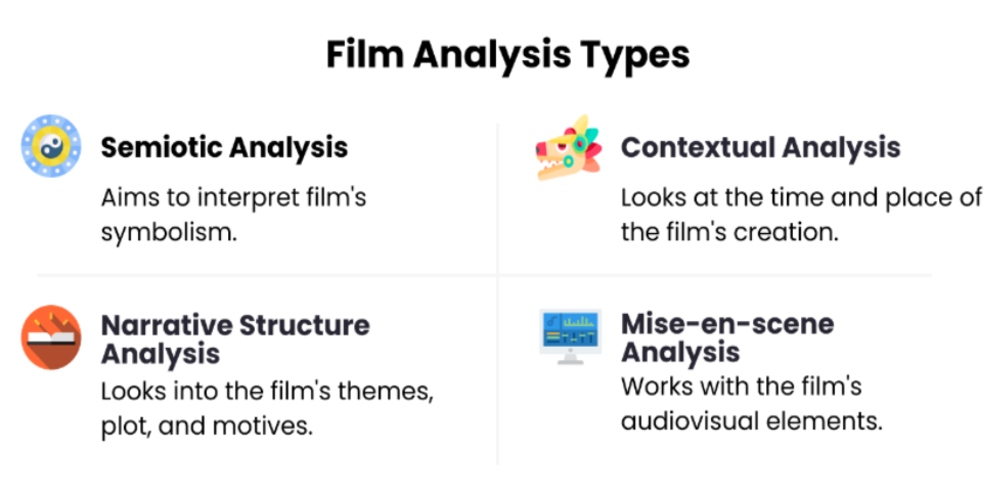A film analysis essay might be the most exciting assignment you have ever had! After all, who doesn’t love watching movies? You have your favorite movies, maybe something you watched years ago, perhaps a classic, or a documentary. Or your professor might assign a film for you to make a critical review. Regardless, you are totally up for watching a movie for a film analysis essay.
However, once you have watched the movie, facing the act of writing might knock the wind out of your sails because you might be wondering how to write a film analysis essay. In summary, writing movie analysis is not as difficult as it might seem, and Custom-writing.org experts will prove this. This guide will help you choose a topic for your movie analysis, make an outline, and write the text.️ Film analysis examples are added as a bonus! Just keep reading our advice on how to get started.
❓ What Is a Film Analysis Essay?
To put it simply, film analysis implies watching a movie and then considering its characteristics: genre, structure, contextual context, etc. Film analysis is usually considered to be a form of rhetorical analysis. The key to success here is to formulate a clear and logical argument, supporting it with examples.
Writing an analytical essay, whether it’s about a film or another subject, requires you to always stay critical and fully aware of the material. Only this way can you present arguments cohesively. If you’re struggling to balance these demands, an analytical essay writing service can help. Our tutors provide professional support in crafting essays with clear arguments and well-structured content, ensuring your work meets academic standards and has the required tone.
🚦 Film Analysis Essay Types
Since a film analysis essay resembles literature analysis, it makes sense that there are several ways to do it. Its types are not limited to the ones described here. Moreover, you are free to combine the approaches in your essay as well. Since your writing reflects your own opinion, there is no universal way to do it.
- Semiotic analysis. If you’re using this approach, you are expected to interpret the film’s symbolism. You should look for any signs that may have a hidden meaning. Often, they reveal some character’s features. To make the task more manageable, you can try to find the objects or concepts that appear on the screen multiple times. What is the context they appear in? It might lead you to the hidden meaning of the symbols.
- Narrative structure analysis. This type is quite similar to a typical literature guide. It includes looking into the film’s themes, plot, and motives. The analysis aims to identify three main elements: setup, confrontation, and resolution. You should find out whether the film follows this structure and what effect it creates. It will make the narrative structure analysis essay if you write about the theme and characters’ motivations as well.
- Contextual analysis. Here, you would need to expand your perspective. Instead of focusing on inner elements, the contextual analysis looks at the time and place of the film’s creation. Therefore, you should work on studying the cultural context a lot. It can also be a good idea to mention the main socio-political issues of the time. You can even relate the film’s success to the director or producer and their career.
- Mise-en-scene analysis. This type of analysis works with the most distinctive feature of the movies, audiovisual elements. However, don’t forget that your task is not only to identify them but also to explain their importance. There are so many interconnected pieces of this puzzle: the light to create the mood, the props to show off characters’ personalities, messages hidden in the song lyrics.

📽️ Movie Analysis Format
To write an effective film analysis essay, it is important to follow specific format requirements that include the following:
- Standard essay structure. Just as with any essay, your analysis should consist of an introduction with a strong thesis statement, body paragraphs, and a conclusion. The main body usually includes a summary and an analysis of the movie’s elements.
- Present tense for events in the film. Use the present tense when describing everything that happens in the movie. This way, you can make smooth transitions between describing action and dialogue. It will also improve the overall narrative flow.
- Proper formatting of the film’s title. Don’t enclose the movie’s title in quotation marks; instead, italicize it. In addition, use the title case: that is, capitalize all major words.
- Proper use of the characters’ names. When you mention a film character for the first time, name the actor portraying them. After that, it is enough to write only the character’s name.
- In-text citations. Use in-text citations when describing certain scenes or shots from the movie. Format them according to your chosen citation style. If you use direct quotes, include the time-stamp range instead of page numbers. Here’s how it looks in the MLA format: (Smith 0:11:24–0:12:35).
✍️ How to Write a Film Analysis
Even though film analysis is similar to the literary one, you might still feel confused with where to begin. No need to worry; there are only a few additional steps you need to consider during the writing process.
Need more information? It can be found in the video below.
Starting Your Film Analysis Essay
There are several things you need to do before you start writing your film analysis paper. First and foremost, you have to watch the movie. Even if you have seen it a hundred times, you need to watch it again to make a good film analysis essay.
Note that you might be given an essay topic or have to think of it by yourself. If you are free to choose a topic for your film analysis essay, reading some critical reviews before you watch the film might be a good idea. By doing this in advance, you will already know what to look for when watching the movie.
In the process of watching, keep the following tips in mind:
- Consider your impression of the movie
- Enumerate memorable details
- Try to interpret the movie message in your way
- Search for the proof of your ideas (quotes from the film)
- Make comments on the plot, settings, and characters
- Draw parallels between the movie you are reviewing and some other movies
Making a Film Analysis Essay Outline
Once you have watched and possibly re-watched your assigned or chosen movie from an analytical point of view, you will need to create a movie analysis essay outline. The task is pretty straightforward: the outline can look just as if you were working on a literary analysis or an article analysis.
- Introduction: This includes the basics of the movie, including the title, director, and the date of release. You should also present the central theme or ideas in the movie and your thesis statement.
- Summary: This is where you take the time to present an overview of the primary concepts in the movie, including the five Ws (who, what, when, where, and why)—don’t forget how!—as well as anything you wish to discuss that relates to the point of view, style, and structure.
- Analysis: This is the body of the essay and includes your critical analysis of the movie, why you did or did not like it, and any supporting material from the film to support your views. It would help if you also discussed whether the director and writer of the movie achieved the goal they set out to achieve.
- Conclusion: This is where you can state your thesis again and provide a summary of the primary concepts in a new and more convincing manner, making a case for your analysis. You can also include a call-to-action that will invite the reader to watch the movie or avoid it entirely.
You can find a great critical analysis template at Thompson Rivers University website. In case you need more guidance on how to write an analytical paper, check out our article.
Writing & Editing Your Film Analysis Essay
We have already mentioned that there are differences between literary analysis and film analysis. They become especially important when one starts writing their film analysis essay.
First of all, the evidence you include to support the arguments is not the same. Instead of quoting the text, you might need to describe the audiovisual elements.
However, the practice of describing the events is similar in both types. You should always introduce a particular sequence in the present tense. If you want to use a piece of a dialogue between more than two film characters, you can use block quotes. However, since there are different ways to do it, confirm with your supervisor.
For your convenience, you might as well use the format of the script, for which you don’t have to use quotation marks:
Example:
ELSA: But she won’t remember I have powers?
KING: It’s for the best.
Finally, to show off your proficiency in the subject, look at the big picture. Instead of just presenting the main elements in your analysis, point out their significance. Describe the effect they make on the overall impression form the film. Moreover, you can dig deeper and suggest the reasons why such elements were used in a particular scene to show your expertise.
🎦 Film Analysis Template
Stuck writing a film analysis essay? Worry not! Use our template to structure your movie analysis properly.
Introduction
- The title of the film is… [title]
- The director is… [director’s name] He/she is known for… [movies, style, etc.]
- The movie was released on… [release date]
- The themes of the movie are… [state the film’s central ideas]
- The film was made because… [state the reasons]
- The movie is… because… [your thesis statement].
Summary
- The main characters are… [characters’ names]
- The events take place in… [location]
- The movie is set in… [time period]
- The movie is about… [state what happens in the film and why]
Analysis
- The movie left a… [bad, unforgettable, lasting, etc.] impression in me.
- The script has… [a logical sequence of events, interesting scenes, strong dialogues, character development, etc.]
- The actors portray their characters… [convincingly, with intensity, with varying degree of success, in a manner that feels unnatural, etc.]
- The soundtrack is [distracting, fitting, memorable, etc.]
- Visual elements such as… [costumes, special effects, etc.] make the film [impressive, more authentic, atmospheric, etc.]
- The film succeeds/doesn’t succeed in engaging the target audience because it… [tells a compelling story, features strong performances, is relevant, lacks focus, is unauthentic, etc.]
- Cultural and societal aspects make the film… [thought-provoking, relevant, insightful, problematic, polarizing, etc.]
- The director and writer achieved their goal because… [state the reasons]
Conclusion
- Overall, the film is… [state your opinion]
- I would/wouldn’t recommend watching the movie because… [state the reasons]
🎬 Film Analysis Essay Topics
- Analysis of the film Inception by Christopher Nolan.
- Examine the rhetoric in the film The Red Balloon.
- Analyze the visual effects of Zhang Yimou’s movie Hero.
- Basic concepts of the film Interstellar by Christopher Nolan.
- The characteristic features of Federico Fellini’s movies.
- Analysis of the movie The Joker.
- The depiction of ethical issues in Damaged Care.
- Analyze the plot of the film Moneyball.
- Explore the persuasive techniques used in Henry V.
- Analyze the movie Killing Kennedy.
- Discuss the themes of the film Secret Window.
- Describe the role of audio and video effects in conveying the message of the documentary Life in Renaissance.
- Compare and analyze the films Midnight Cowboy and McCabe and Mrs. Miller.
- Analysis of the movie Rear Window.
- The message behind the film Split.
- Analyze the techniques used by Tim Burton in his movie Sleepy Hollow.
- The topic of children’s abuse and importance of trust in Joseph Sargent’s Sybil.
- Examine the themes and motives of the film Return to Paradise by Joseph Ruben.
- The issues of gender and traditions in the drama The Whale Rider.
- Analysis of the film Not Easily Broken by Duke Bill.
- The symbolism in R. Scott’s movie Thelma and Louise.
- The meaning of audiovisual effects in Citizen Kane.
- Analyze the main characters of The Girl with the Dragon Tattoo.
- Discuss the historical accuracy of the documentary The Civil War.
- Analysis of the movie Through a Glass Darkly.
- Explore the core idea of the comedy Get Out.
- The problem of artificial intelligence and human nature in Ex Machina.
- Three principles of suspense used in the drama The Fugitive.
- Examine the ideas Michael Bay promotes in Armageddon.
- Analyze the visual techniques used in Tenet by Christopher Nolan.
- Analysis of the movie The Green Mile.
- Discrimination and exclusion in the film The Higher Learning.
- The hidden meaning of the scenes in Blade Runner.
- Compare the social messages of the films West Side Story and Romeo + Juliet.
- Highlighting the problem of children’s mental health in the documentary Kids in Crisis.
- Discuss the ways Paul Haggis establishes the issue of racial biases in his movie Crash.
- Analyze the problem of moral choice in the film Gone Baby Gone.
- Analysis of the historical film Hacksaw Ridge.
- Explore the main themes of the film Mean Girls by Mark Walters.
- The importance of communication in the movie Juno.
- Describe the techniques the authors use to highlight the problems of society in Queen and Slim.
- Examine the significance of visual scenes in My Family/ Mi Familia.
- Analysis of the thriller Salt by Phillip Noyce.
- Analyze the message of Greg Berlanti’s film Love, Simon.
- Interpret the symbols of the film The Wizard of Oz (1939).
- Discuss the modern issues depicted in the film The Corporation.
- Moral lessons of Edward Zwick’s Blood Diamond.
- Analysis of the documentary Solitary Nation.
- Describe the audiovisual elements of the film Pride and Prejudice (2005).
- The problem of toxic relationships in Malcolm and Marie.
📄 Film Analysis Examples
Below you’ll find two film analysis essay examples. Note that the full versions are downloadable for free!
Film Analysis Example #1: The Intouchables
Example:
Raising acute social problems in modern cinema is a common approach to draw the public’s attention to the specific issues and challenges of people facing crucial obstacles. As a film for review, The Intouchables by Oliver Nakache and Éric Toledano will be analyzed, and one of the themes raised in this movie is the daily struggle of the person with severe disabilities. This movie is a biographical drama with comedy elements. The Intouchables describes the routine life of a French millionaire who is confined to a wheelchair and forced to receive help from his servants. The acquaintance of the disabled person with a young and daring man from Parisian slums changes the lives of both radically. The film shows that for a person with disabilities, recognition as a full member of society is more important than sympathy and compassion, and this message expressed comically raises an essential problem of human loneliness.
Movie Analysis Example #2: Parasite
Example:
Parasite is a 2019 South Korean black comedy thriller movie directed by Bong Joon-ho and is the first film with a non-English script to win Best Picture at the Oscars in 2020. With its overwhelming plot and acting, this motion picture retains a long-lasting effect and some kind of shock. The class serves as a backbone and a primary objective of social commentary within the South Korean comedy/thriller (Kench, 2020). Every single element and detail in the movie, including the student’s stone, the contrasting architecture, family names, and characters’ behavior, contribute to the central topic of the universal problem of classism and wealth disparity. The 2020 Oscar-winning movie Parasite (2019) is a phenomenal cinematic portrayal and a critical message to modern society regarding the severe outcomes of the long-established inequalities within capitalism.
Want more examples? Check out this bonus list of 10 film analysis samples. They will help you gain even more inspiration.
- “Miss Representation” Documentary Film Analysis
- “The Patriot”: Historical Film Analysis
- “The Morning Guy” Film Analysis
- 2012′ by Roland Emmerich Film Analysis
- “The Crucible” (1996) Film Analysis
- The Aviator’ by Martin Scorsese Film Analysis
- The “Lions for Lambs” Film Analysis
- Bill Monroe – Father of Bluegrass Music Film Analysis
- Lord of the Rings’ and ‘Harry Potter’ Film Analysis
- Red Tails by George Lucas Film Analysis
🔗 References
- Film Analysis – UNC Writing Center
- Film Writing: Sample Analysis // Purdue Writing Lab
- Yale Film Analysis – Yale University
- Film Terms And Topics For Film Analysis And Writing
- Questions for Film Analysis (Washington University)
- Resources on Film Analysis – Cinema Studies (University of Toronto)
- Does Film Analysis Take the Magic out of Movies?
- Film Analysis Research Papers – Academia.edu
- What’s In a Film Analysis Essay? Medium
- Analysis of Film – SAGE Research Methods




![Short Story Analysis: How to Write It Step by Step [New]](https://custom-writing.org/blog/wp-content/uploads/2020/12/man-sits-end-trolltunga-before-mountains-284x153.jpg)

![Common Essay Mistakes—Writing Errors to Avoid [Updated]](https://custom-writing.org/blog/wp-content/uploads/2020/12/avoid-mistakes-ccw-284x153.jpg)

![Why I Want to Be a Teacher Essay: Writing Guide [2025]](https://custom-writing.org/blog/wp-content/uploads/2020/12/senior-male-professor-writing-blackboard-with-chalk3-284x153.jpg)
![Friendship Essay: Writing Guide & Topics on Friendship [New]](https://custom-writing.org/blog/wp-content/uploads/2020/12/smiley-female-friends-fist-bumping-284x153.jpg)


Have you ever read a review and asked yourself how the critic arrived at a different interpretation for the film? You are sure that you saw the same movie, but you interpreted it differently. Most moviegoers go to the cinema for pleasure and entertainment. There’s a reason why blockbuster movies attract moviegoers – cinema is a form of escape, a way to momentarily walk away from life’s troubles.
EXCELENT COVERAGE!
Hi Rebecca,
Glad you liked the post. Sure thing, feel free to share the link with your audience!
All the best.